
Fossils of the Cretaceous
The remains of feathered dinosaurs, spectacular as they may
be, are just some of the wonders that Chinese paleontologists
have discovered in the fossil beds of Liaoning Province. In
this area of northeastern China roughly 130 million years ago,
volcanoes repeatedly and catastrophically showered down
fine-grained ash, capturing remarkable details of many doomed
ancient animals—skin texture, fur, and downy
filaments—as well as preserving delicate plants usually
missing in the fossil record. The abundance and quality of the
fossils have allowed scientists to reconstruct a vivid picture
of an Early Cretaceous ecosystem and gain insights into how
modern plants and animals evolved. Below, get a glimpse of the
creatures—some familiar, others entirely
alien—that inhabited the forests, marshlands, rivers,
and lakes of the region long ago.—Susan K. Lewis
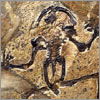

|
|
Frog
Mesophryne
Splayed out like a dissected animal in a high school
biology class, this fossil leaves little doubt as to
what kind of creature it once was. Frogs are extremely
ancient, dating back some 250 million years. By the time
this animal lived, more than 100 million years later,
numerous species of frogs likely rested on the muddy
shores of Liaoning's lakes, though fossil hunters have
yet identified only a few. Some of these species appear
closely akin to frogs now hopping about Asia, Europe,
and North Africa—and even savored as culinary
treats in modern-day Liaoning.
|
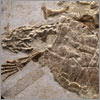

|
|
Turtle
Ordosemys
While this particular animal lived at the time of
Microraptor, turtles evolved at least 230 million
years ago, long before the Liaoning fossil time. Even
the earliest turtles, with their characteristic shells,
resembled modern ones. The fossils of Liaoning are of
two kinds: soft-shell turtles related to species living
today, and—brace yourself—nanhsiungchelyids,
which Mark Norell notes "have lumpy shells, huge noses
(the largest in turtledom), long tails, and a very
hard-to-pronounce name coined after the locality where
these animals were first found."
|
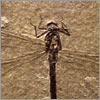

|
|
Dragonfly
Aeschnidium
The tissue-thin membranes of this dragonfly's wings are
so immaculately preserved that it's easy to picture the
insect skimming along the surface of a lake at dusk 130
million years ago. Perhaps the toxic gas of a volcanic
eruption suffocated it, and a fine coating of volcanic
ash protected its fragile remains. Unlike their
comparatively colossal ancient forbears, which had
wingspans stretching over two feet, dragonflies of the
Early Cretaceous were similar in size and anatomy to
those flying through wetlands today.
|
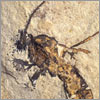

|
|
Hornet
This fossil, likely that of a primitive hornet, belongs
to a group of stinging insects called Hymenoptera.
Insects evolved into the general types we see today
about 250 million years ago, when dinosaurs and small
mammals first appeared. It wasn't until the Early
Cretaceous, however, that groups such as Hymenoptera
began to diversify—a process linked to the
evolution of the earliest flowering plants. When this
hornet lived, for instance, its cousin the honeybee had
yet to make its evolutionary appearance.
|
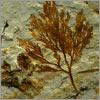

|
|
Fern
Botrychites
If you were suddenly transported into a Liaoning forest
130 million years ago, you would likely see a variety of
ferns in the understory, including this one, and be
surrounded by gingko trees and conifers similar to
modern pines and firs. Along the shores of lakes, you
might step through horsetails and other marsh plants,
and possibly catch a glimpse of the oldest known
flowering plant, called Archaefructus
or "ancient fruit," which may have spread its pollen via
water. (Like all early flowering plants, it lacked
showy, colorful blossoms to attract insects and other
animal pollinators.)
|
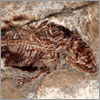

|
|
Mammal
Maotherium
Mark Norell may not be wowed by this specimen, which he
compares to "a flat rat on a New York street." But even
this seasoned paleontologist agrees that the fossil's
details are exceptional. Perhaps most striking is the
aura-like fringe of fur surrounding the skeleton. Small
mammals are as ancient as dinosaurs. In fact, until the
demise of traditional (non-avian) dinosaurs at the end
of the Cretaceous, most mammals remained small, hunting
insects, scavenging nests, and living in the shadow of
dominant reptiles.
|
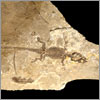

|
|
Champsosaur and fish
Monjurosuchus & Lycoptera
Like many Liaoning fossils, this one captures the
remnants of several animals that died simultaneously,
perhaps killed by a volcanic event. The champsosaur, a
superficially crocodile-like reptile, is about a foot
long. Fish are the most common backboned animals in the
fossil beds, and the most prevalent are herring-like
Lycoptera. Fossil hunters have discovered
thousands of specimens in a single layer of sedimentary
rock. Aquatic animals and plants, in general, often
became spectacular fossils, as fine-grained sediments
were likely to drift to the bottoms of lakes and ponds.
|
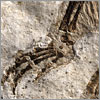

|
|
Champsosaur skin impression
Notice the scales on the skin (around the "knee") and
webbing between the toes. The flesh appears like a
ghostly halo, while the vertebrae and other bones are
sharp and three-dimensional. This reflects the different
ways in which hard parts (bone and teeth) and soft
tissue (such as skin and internal organs) are
fossilized. Bones become fossils as minerals replace
organic structures on a molecular level. In contrast,
bacteria create the blurry traces of soft tissue. As the
bacteria consume skin, fur, feathers, and other soft
tissue, they leave metabolic deposits in the shapes of
their meals.
|
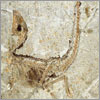

|
|
Dinosaur with proto-feathers
Sinosauropteryx
The full name of this animal,
Sinosauropteryx prima, means "first Chinese
winged lizard." Its discovery in the mid-1990s delighted
many paleontologists who suspected that birds are close
kin to dinosaurs. This fossil offered evidence in the
form of downy, short feathers all along the animal's
head, back, and tail. A carnivorous dinosaur about the
size of a greyhound, Sinosauropteryx likely ran
swiftly on its two hind legs. With fuzzy feathers just a
few millimeters long, it is unlikely that it ever flew.
The feathers could, however, help keep the dinosaur warm
through cool nights in the temperate forest.
|
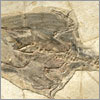

|
|
Ancient bird
Confuciusornis
When feathered dinosaurs roamed the land, true birds
soared through the Liaoning skies. Some were as big as
albatrosses; others, such as this Confuciusornis,
were more the size of pigeons. This fossil, dating to
about 120 million years ago, reveals characteristics
that make Confuciusornis a mix of primitive (more
dinosaur-like) and advanced (modern bird-like) traits:
Like dinosaurs and the oldest known bird,
Archaeopteryx, it has three fingers that are not
fused into a single element, but like modern birds, it
has a toothless beak and a well-developed shoulder
girdle to power flight.
|
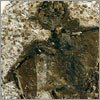

|
|
Pterosaur
Dendrorynchoides
The true masters of the Liaoning skies were pterosaurs,
flying reptiles that preyed upon birds, mammals, small
dinosaurs, and fish. Museum dioramas often depict them
as giants, but some pterosaurs, like this specimen, were
no bigger than swallows. A single, very elongated fourth
finger formed the leading edge and support for the
pterosaur's wing. The skin membrane stretched from wrist
to ankle and even between the hind limbs. This fossil
reveals an astounding covering of fuzz, suggesting that
proto-feathers may have evolved in an animal that was a
common ancestor to both pterosaurs and dinosaurs.
|
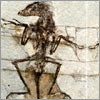

|
|
Feathered dinosaur
Sinornithosaurus
When his Chinese colleague Ji Qiang first showed Mark
Norell this fossil in 1999, Norell thought it was the
greatest dinosaur specimen he had ever seen. The
feathers on this small dinosaur, which Norell
affectionately calls "Dave," are much more pronounced
than those on the "first feathered dinosaur,"
Sinosauropteryx prima. Dave's feathers also come
in three types: simple hair-like fibers (primarily on
the head and tail), sprays of fibers (apparent on the
hind limbs and shoulders), and asymmetrical feathers
like those of a modern bird (on the trailing edge of the
arm).
|
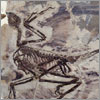

|
|
Four-winged dinosaur
Microraptor
Like other great discoveries in Liaoning over the past
two decades, Microraptor has transformed
scientific understanding and pop-culture imagery of what
dinosaurs of the Early Cretaceous looked like. Whereas
we once might have envisioned smooth-skinned reptiles
plodding along the ground, we now can imagine sprightly,
feathered creatures gliding from tree to tree.
Microraptor's ability to glide, and its exact
flying form, are still debated, but the notion of a
flying feathered dinosaur isn't as outlandish as it may
have seemed a few decades ago.

|
|


We recommend you visit the
interactive version. The text to the left is provided for printing purposes.
|















